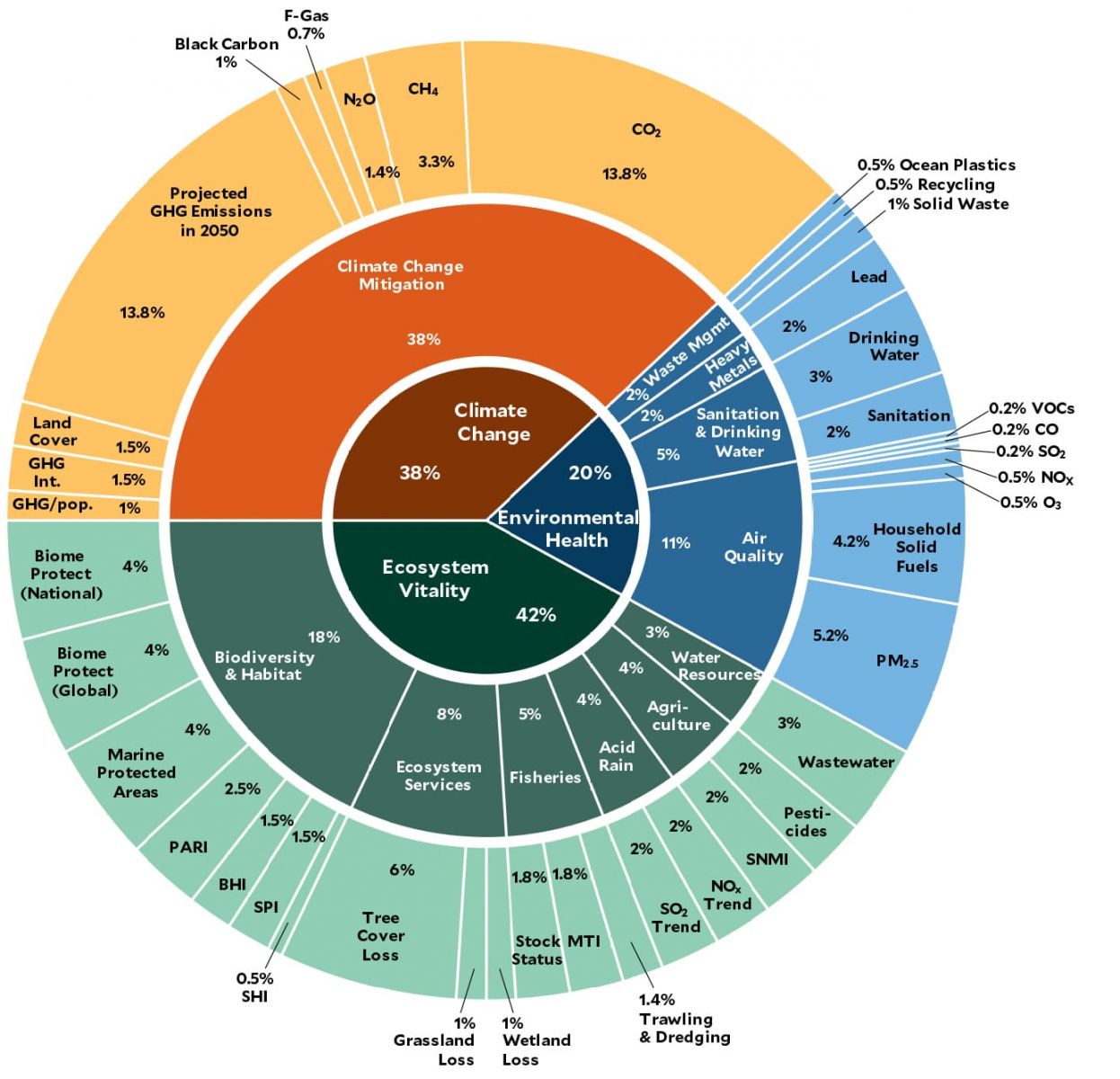Jacob Koshy
NEW DELHI:
NEW DELHI:
JUNE 09, 2022
2022 EPI Framework
The framework organizes 40 indicators into 11 issue categories and three policy objectives, with weights shown at each level as a percentage of the total score.
The the Environmental Performance Index is prepared by researchers at the Yale and Columbia universities in the United States.
India has objected to a report, called the Environmental Performance Index (EPI), 2022, that places India last in a list of 180 countries on managing climate change, environmental health, and ecosystem vitality. The report is prepared by researchers at the Yale and Columbia universities in the United States.
“These indicators provide a gauge at a national scale of how close countries are to the established environmental policy targets. The EPI offers a scorecard that highlights leaders and laggards in environmental performance and provides practical guidance for countries that aspire to move towards a sustainable future,” says the report that places Denmark, United Kingdom and Finland at the top of the list. “High-scoring countries exhibit longstanding and continuing investments in policies that protect environmental health, preserve biodiversity and habitat, conserve natural resources, and decouple greenhouse gas emissions from economic growth.”
India ranked at the bottom of all countries in the 2022 EPI, with low scores across a range of critical issues with “deteriorating air quality and rapidly rising greenhouse gas emissions” posing major challenges, according to the report.
In a detailed rebuttal, the Union Environment Ministry said that it “does not accept the EPI analysis” and pointed out several parameters, which according to it, were incorrectly weighed by the EPI authors.
Thus “Projected Emission levels in 2050,” which carries a weight of 36% in the ‘Climate Change’ sub-category, calculates trends in emissions from 2010-2019 and extrapolates it to 2050.
India being a developing country and the second largest population will have the increasing trend of GHG (greenhouse gas emissions) and so the correct method, the Environment Ministry said, would be to calculate GHG emissions per capita and have a model with the coefficients taking into account the effect of policies to reduce emissions like increase in use of renewable energy, electric vehicles, creation of carbon sink, etc., to project the values for future years.
The use of “biased metrics and biased weights” caused India’s low rank as it didn’t account for the fact that India had one of the lowest emission trajectories. The index also didn’t account for the fact that developed nations past emissions are responsible for the climate crisis.
Per capita GHG emissions contributed only a “miniscule” 2.6% weight overall in the index. India was a party to Paris Agreement and has given a goal of achieving net zero emissions by 2070 and hence comparing it to countries with Projected 2050 emissions level in 2050 equal to or below zero receiving the maximum score is against the principle of Equity as enshrined in the United Nations Framework Convention on Climate Change agreements.
India has objected to a report, called the Environmental Performance Index (EPI), 2022, that places India last in a list of 180 countries on managing climate change, environmental health, and ecosystem vitality. The report is prepared by researchers at the Yale and Columbia universities in the United States.
“These indicators provide a gauge at a national scale of how close countries are to the established environmental policy targets. The EPI offers a scorecard that highlights leaders and laggards in environmental performance and provides practical guidance for countries that aspire to move towards a sustainable future,” says the report that places Denmark, United Kingdom and Finland at the top of the list. “High-scoring countries exhibit longstanding and continuing investments in policies that protect environmental health, preserve biodiversity and habitat, conserve natural resources, and decouple greenhouse gas emissions from economic growth.”
India ranked at the bottom of all countries in the 2022 EPI, with low scores across a range of critical issues with “deteriorating air quality and rapidly rising greenhouse gas emissions” posing major challenges, according to the report.
In a detailed rebuttal, the Union Environment Ministry said that it “does not accept the EPI analysis” and pointed out several parameters, which according to it, were incorrectly weighed by the EPI authors.
Thus “Projected Emission levels in 2050,” which carries a weight of 36% in the ‘Climate Change’ sub-category, calculates trends in emissions from 2010-2019 and extrapolates it to 2050.
India being a developing country and the second largest population will have the increasing trend of GHG (greenhouse gas emissions) and so the correct method, the Environment Ministry said, would be to calculate GHG emissions per capita and have a model with the coefficients taking into account the effect of policies to reduce emissions like increase in use of renewable energy, electric vehicles, creation of carbon sink, etc., to project the values for future years.
The use of “biased metrics and biased weights” caused India’s low rank as it didn’t account for the fact that India had one of the lowest emission trajectories. The index also didn’t account for the fact that developed nations past emissions are responsible for the climate crisis.
Per capita GHG emissions contributed only a “miniscule” 2.6% weight overall in the index. India was a party to Paris Agreement and has given a goal of achieving net zero emissions by 2070 and hence comparing it to countries with Projected 2050 emissions level in 2050 equal to or below zero receiving the maximum score is against the principle of Equity as enshrined in the United Nations Framework Convention on Climate Change agreements.
No comments:
Post a Comment